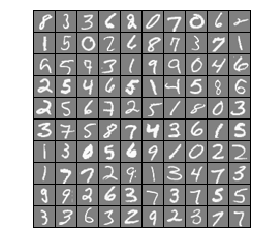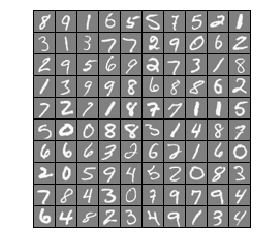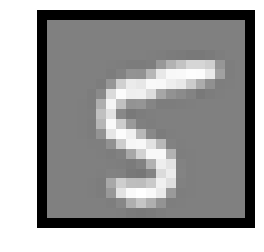Exercise 3 | Part 1: One-vs-all
=========== Part 1: Loading and Visualizing Data =============
from ex3 import *
## Setup the parameters you will use for this part of the exercise
input_layer_size = 400 # 20x20 Input Images of Digits
num_labels = 10 # 10 labels, from 1 to 10
# (note that we have mapped "0" to label 10)
# Load Training Data
print('Loading and Visualizing Data ...')
from scipy import io as sio
data = sio.loadmat('ex3data1.mat') # training data stored in arrays X, y
X = data['X']
y = data['y'].reshape(-1)
m = X.shape[0]
# Randomly select 100 data points to display
rand_indices = np.random.permutation(m)
sel = X[rand_indices[:100], :]
%matplotlib inline
_ = displayData(sel)
Loading and Visualizing Data ...

============ Part 2a: Vectorize Logistic Regression ============
# Test case for lrCostFunction
print('Testing lrCostFunction() with regularization')
theta_t = np.array([-2, -1, 1, 2])
X_t = np.column_stack([np.ones(5), np.arange(0.1, 1.6, 0.1).reshape((5, 3), order='F')])
y_t = np.array([1, 0, 1, 0, 1]) >= 0.5
lambda_t = 3
J, grad = lrCostFunction(theta_t, X_t, y_t, lambda_t)
print(f'\nCost: {J:f}')
print('Expected cost: 2.534819')
print('Gradients:')
print(f' {grad} ')
print('Expected gradients:')
print(' 0.146561\n -0.548558\n 0.724722\n 1.398003')
Testing lrCostFunction() with regularization
Cost: 2.534819
Expected cost: 2.534819
Gradients:
[ 0.146561 -0.548558 0.724722 1.398003]
Expected gradients:
0.146561
-0.548558
0.724722
1.398003
============ Part 2b: One-vs-All Training ============
print('Training One-vs-All Logistic Regression...')
lambda_ = 1
all_theta = oneVsAll(X, y, num_labels, lambda_)
Training One-vs-All Logistic Regression...
Optimization terminated successfully.
Current function value: 0.026960
Iterations: 63
Function evaluations: 218
Gradient evaluations: 218
Optimization terminated successfully.
Current function value: 0.068445
Iterations: 96
Function evaluations: 278
Gradient evaluations: 278
Optimization terminated successfully.
Current function value: 0.071707
Iterations: 108
Function evaluations: 292
Gradient evaluations: 292
Optimization terminated successfully.
Current function value: 0.052051
Iterations: 84
Function evaluations: 255
Gradient evaluations: 255
Optimization terminated successfully.
Current function value: 0.076859
Iterations: 121
Function evaluations: 332
Gradient evaluations: 332
Optimization terminated successfully.
Current function value: 0.034787
Iterations: 79
Function evaluations: 262
Gradient evaluations: 262
Optimization terminated successfully.
Current function value: 0.046725
Iterations: 78
Function evaluations: 240
Gradient evaluations: 240
Optimization terminated successfully.
Current function value: 0.092747
Iterations: 139
Function evaluations: 368
Gradient evaluations: 368
Optimization terminated successfully.
Current function value: 0.089311
Iterations: 131
Function evaluations: 354
Gradient evaluations: 354
Optimization terminated successfully.
Current function value: 0.020148
Iterations: 65
Function evaluations: 225
Gradient evaluations: 225
好了,应该都收敛了。
=============== Part 3: Predict for One-Vs-All ===============
pred = predictOneVsAll(all_theta, X)
print(f'Training Set Accuracy: {(pred == y).mean() * 100:f}')
Training Set Accuracy: 94.460000
结果有点小误差,应该是\(\lambda\)取值问题。
以上部分代码在ex3.py中
Exercise 3 | Part 2: Neural Networks
=========== Part 1: Loading and Visualizing Data =============
## Setup the parameters you will use for this exercise
input_layer_size = 400 # 20x20 Input Images of Digits
hidden_layer_size = 25 # 25 hidden units
num_labels = 10 # 10 labels, from 1 to 10
# (note that we have mapped "0" to label 10)
# Load Training Data
print('Loading and Visualizing Data ...')
from scipy import io as sio
data = sio.loadmat('ex3data1.mat')
X = data['X']
y = data['y'].reshape(-1)
m = X.shape[0]
# Randomly select 100 data points to display
sel = np.random.permutation(m)
sel = sel[:100]
%matplotlib inline
_ = displayData(X[sel, :])
Loading and Visualizing Data ...

================ Part 2: Loading Pameters ================
print('Loading Saved Neural Network Parameters ...')
# Load the weights into variables Theta1 and Theta2
data = sio.loadmat('ex3weights.mat')
Theta1 = data['Theta1']
Theta2 = data['Theta2']
print(Theta1.shape, Theta2.shape)
Loading Saved Neural Network Parameters ...
(25, 401) (10, 26)
================= Part 3: Implement Predict =================
pred = predict(Theta1, Theta2, X);
print(f'Training Set Accuracy: {(pred == y).mean() * 100:f}')
Training Set Accuracy: 97.520000
Displayed image:
# Randomly permute examples
rp = np.random.permutation(m)
for i in range(m):
# Display
print('Displaying Example Image')
_ = displayData(X[rp[i], :].reshape((-1, input_layer_size)))
pred = predict(Theta1, Theta2, X[rp[i], :].reshape((-1, input_layer_size)))
print(f'\nNeural Network Prediction: {pred} (digit {pred % 10})')
# Pause with quit option
s = input('Paused - press enter to continue, q to exit:')
if s == 'q':
break
Displaying Example Image

Neural Network Prediction: [2] (digit [2])
Paused - press enter to continue, q to exit:
Displaying Example Image

Neural Network Prediction: [7] (digit [7])
Paused - press enter to continue, q to exit:
Displaying Example Image

Neural Network Prediction: [5] (digit [5])
Paused - press enter to continue, q to exit:
Displaying Example Image

Neural Network Prediction: [2] (digit [2])
Paused - press enter to continue, q to exit:q
嗯,几个例子还是可以的。

